What do we mean by “good footing”?
The riding surface is the footing layer that you can see. Footing is the top layer and should be deep enough to minimize the concussion to the horse’s legs, but not be so deep that it causes strain to muscles and tendons. Sand, chat, decomposed granite, man-made synthetics, polymer sand products, and a variety of other combinations are commonly used as footing materials. In addition to the basics of arena composition, here are a few more points to consider prior to building a new arena or restoring an existing one.
All dirt is not created equal
Robert Malmgren, soil scientist, has identified in his book, The Equine Arena Handbook, that there are over 10,000 scientific classifications of soil. In addition to the scientific names, there are common names for the various types of soil. The common names may vary depending on geographic location as well as the names adopted by soil brokers and construction crews. During the planning and construction process, it is helpful to describe the soil materials needed in terms of particle size and how they will be used.
In the Riata® guide for construction above, you can see the common method of grading and naming materials size. Become familiar with this information, as it will help ensure that the soil materials you purchase are, indeed, the soil materials best suited for the design of the arena. With the expertise, technology, and tools available today, creating a near-perfect arena is most certainly possible. The major variables to consider are time and money. For many of us, those are one in the same.
Here are some factors related to cost that are helpful to consider prior to constructing a new arena or restoring an existing one.
Know your Dirt
Availability varies by location and transporting the soil adds greatly to the overall cost. The $5-$10/ton sand may cost upward of $50 per load to transport. You can minimize the transport miles by purchasing soil and surface materials locally, or as close to the site as possible.
Learn about arena construction and renovation
Before hiring the contractor with expensive equipment and crews, do your due diligence in learning about arena construction and/or renovation. Talk to other riders, trainers, and equine facility managers. Find out what worked for them, what didn’t, and why. Ask about the types of problems and maintenance issues they’ve noticed with the various riding surface materials. Read about arena construction, renovation, and maintenance.
Remember to consider water and drainage before breaking ground
The riding surface is the footing layer that you can see. Footing is the top layer and should be deep enough to minimize the concussion to the horse’s legs, but not be so deep that it causes strain to muscles and tendons. Sand, chat, decomposed granite, man-made synthetics, polymer sand products, and a variety of other combinations are commonly used as footing materials. In addition to the basics of arena composition, here are a few more points to consider prior to building a new arena or restoring an existing one.
Good drainage is especially important in the design of an outdoor arena. Good drainage will facilitate rapid runoff of rainwater and increase the number of days the arena is rideable. Proper drainage will also minimize the damaging effects of erosion and frost heave. Water is an important element in maintaining a properly functioning riding surface as well as an important dust control measure. This is especially an issue with indoor arenas where some type of watering system will be needed. Consider conservation as well as cost.
Dust control, rut, or build up along the rail, uneven footing and hard or slippery spots can all be minimized by proper arena maintenance with an “equine” designed footing tool. Remember, it will cost more to fix footing problems after they occur than to prevent them from the beginning through proper construction and proper maintenance. If possible, build a bigger arena than you actually need. This will allow you to vary the position of your workout routine.
Drag your arena often and buy the best arena drag you can afford. Proper maintenance is essential for protecting your investments. A good drag should re-compact the aerated footing to provide a stable surface that your horse can “move from.” The best arena implements also level the surface in the process. A drag attached with a three-point hitch will often work better than a trailed harrow in many circumstances. Stay away from blanket or chain harrows, they tend to ‘drag’ the surface materials from the low spots to the high spots, compounding the problem of unevenness within the riding surface. Additionally, they do nothing underneath the surface. We also recommend NOT using a box blade for your equestrian arena. The rippers on the box blade will undermine your base, which is the heart of your arena. Follow a pattern (alternate direction with each grooming) for using your drag like the one shown here: Riata® developed pattern for periodic maintenance. With a little knowledge, patience, and consistency, you will learn to maintain a near perfect arena. Good luck!
What do we mean by “good footing”?
The riding surface is the footing layer that you can see. Footing is the top layer and should be deep enough to minimize the concussion to the horse’s legs, but not be so deep that it causes strain to muscles and tendons. Sand, chat, decomposed granite, man-made synthetics, polymer sand products, and a variety of other combinations are commonly used as footing materials. In addition to the basics of arena composition, here are a few more points to consider prior to building a new arena or restoring an existing one.


